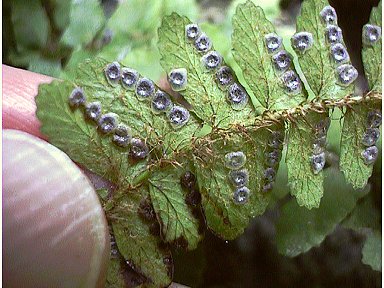|
Hardy Fern Home P. craspedosorum resources
All Ferns � Dryopteridaceae �� Polystichum
�Other Genera
|
| Polystichum craspedosorum | ||
Shield fern | ||
|
Etymology
Craspedosorum is from kraspedon, fringe + sorum, the spore dots, seemingly referring to fringed sori.
Description
Rhizome: erect, small, bearing a few fronds in a whorl, persistent into the next season, scales lanceolate, gradually narrowing towards caudate apex, 2--4 mm long, brown.
Frond: 18 cm high by 4 cm wide, evergreen, monomorphic, blade/stipe ratio: 6:1. Stipe: grooved, rather densely scaly throughout, vascular bundles: 4 or more, in an arc. Blade: 1-pinnate, lanceolate, blades almost horizontal, widest at the middle, the proliferous tip rooting, papyraceous. matt-green, lanceolate to linear, rachis with yellowish brown to brown, and hair-margined scales, pinnae with linear scales on lower surface. Pinnae: 20 to 35 pair, oblong-ovate, round at apex, short-stalked, 1--3 cm long; margins shallowly dentate ; veins free, forked, anadromic. Sori: round, in 1 rows near the margin, indusium: peltate, large, persistent, overlapping, brown, central. Culture
Habitat: on rocky slopes in moist places in mountain forests, often forming colonies.
Distribution: eastern Siberia, China, Japan, Korea, Manchuria.
Hardy to -25�C, USDA Zone 5.
Synonyms
Aspidium craspedosorum Maxim. Ptilopteris craspedosora (Maxim.) Hayata Dryopteris craspedosora O. Ktze. Hemesteum craspedosorum L�veill� Polystichum leucochlamys Christ Ptilopteris craspedosora (Maxim.) Hayata |
|
|
